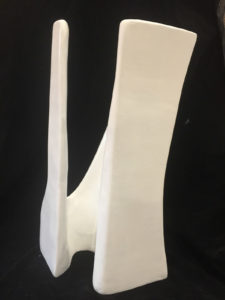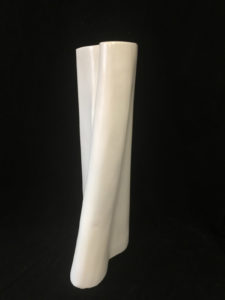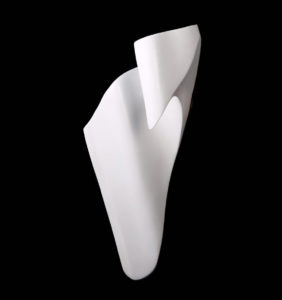The works of the Iranian artist, Golnar Ghasimi (1974) are full of metaphysical and surreal suggestions: in a silent atmosphere inhabited by plastic elements that interrogate space with their mysterious presence, there are hints of biomorphic forms and free creations of geometric matrix. Each sculpture praises its monologue of existential restlessness in the heraldic nobility of a very pure model and in the elegance with which it occupies space. The artist models the fiberglass to create candid abstract forms in which geometric planes and perspectives seem to encounter a sort of “controlled unpredictability” that makes them alive and sentient. They are noble figures from an immeasurably distant time in the past or future, who impersonate alchemical spiritual forms through which art explores the unknown dimensions of the inner universe in search of the secret connections between sensitive reality and the realm of the supreme ideas of which the latter is a reflection.
The essentiality of the forms hides a complex formal and symbolic synthesis which translates into planes, surfaces and rounded corners a multi-dimensional thought that pursues the affirmation of infinity starting from the finiteness of a tangible object. If the objects of space are constructions or images of thought that seek to concretize unreachable ideal models, the only way to experience perfection is to live its absence. The melancholy and loneliness of man generated by the awareness of this impossibility in the course of his existence find comfort in impromptu visions of the Sacred and the Divine (intended as the living presence of Thought) whose essenceonly art can attempt to capture. The imperfections of the ego and subjective knowledge, the epoch-making detachment of human consciousness from both the external and the internal world, leads the artist to seek greater control but also a more intimate relationship with the incidence of chance and with the unpredictable changes brought about by the passage of time. The sculptural object is in fact an event that happens over time, it is the result of a process and therefore a transitory phenomenon. This Taoistconcept identifies the world with the unlimited universe of processes, from which mathematical thought also originates. Transience as an unstable reflection, the passage of time as a measure of a slow progress of eternity in which we are immersed and where the truth does not consist in the illusion of permanence, but in the fluidity of perennial transformation.
Therefore, Golnar Ghasimi’s sculpture is not a copy of a fact that has already happened but it is itself a concrete fact in which the hand meets the materials and manipulates them, leaving in them the imprint of an idea. Here the emblematic function of form understood as a phantasmatic presence that inhabits the mind, as a study and discovery of new classes of solids, all similar but none the same as the other, born from the contamination between geometric and natural categories, appears clear. These simple and luminous forms manifest the conscious illusion of giving substance to infinity and arise from the abandonment of any more directly phenomenal sensation in favor of a conceptual reflection in which sculpture is not only pure ideation but is the physicality of the tension between the sculpturalpresence and the surrounding emptiness.
The image can never be exhausted, it is a continuous process of searching for new apparitions, space-time events, subconscious reactivations of memory, back thoughts, dream impressions and modulations of reason. Golnar Ghasimi departs from the austerity of minimalism, to which the sobriety of the forms could immediately make one think, for the exciting interpenetration between physical body and spiritual form recognizable in the harmony of her sculptures, direct impressions of the arcane presences that are formed beyond consciousness and that echo nostalgia for an impossible perfection. The artist’s attempt to establish a dialogue with eternity to represent the secret connections of the thinking ego with the world translates into magniloquent plastic apparitions that induce the observer to fantasize in search of possible truths. The morphology of the figures of her visionary world seems to allude to hermetic idols from distant civilizations, symbolic presences that do not belong to the time of history but to that of mythology.
The artist translates the relationship between light and darkness, presence and absence, the knowledge of the perspective space and the absence of certain references to tear apart the diaphragm that separates the earthly dimension of the senses from the celestial one of ideas supreme.
There are no precise indications that can guide us towards the meanings of these presences, perhaps interpretable as sentinels of art that indicate the way of initiation, symbols of cognitive power or magical tools to perform wonders. Their enigmatic strength lies in the act of alluding and not specifying any identity, letting us imagine an extended and real universe that coincides with the forms of the unconscious, with the inexplicable mystery of the invisible and the incalculable. The solitude of the sculptures, perfectly self-sufficient in their clear plastic-spatial structure, emphasizes the load of mystery and silent contemplation that their refined symbolic elegance entails, transfiguring the real surrounding space into a sort of symbolic space where thought represents itself. This uninterrupted circularity between rationality and imagination creates a common ground on which the analytical rigor is grafted on the level of sensory emotion in the essentiality of an existential question that investigating the original sense of thought reaches the pure poetry of form.
Info:
 Golnar Ghasimi, Untitled. Sculpture, 28 x 59 x 25 cm, 2018
Golnar Ghasimi, Untitled. Sculpture, 28 x 59 x 25 cm, 2018
 Golnar Ghasimi, Untitled. Sculpture, 24 x 53 x 10 cm, 2018
Golnar Ghasimi, Untitled. Sculpture, 24 x 53 x 10 cm, 2018
 Golnar Ghasimi, Untitled. Sculpture, 22 x 60 x 12 cm, 2017
Golnar Ghasimi, Untitled. Sculpture, 22 x 60 x 12 cm, 2017

Graduated in contemporary art, has been working in collaboration with various contemporary art galleries, private foundations, art centers in Italy and abroad.






NO COMMENT